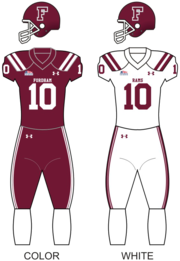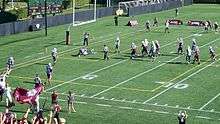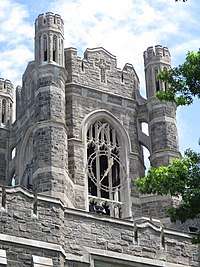Fordham Rams football
The Fordham Rams football program is the intercollegiate American football team for Fordham University located in the U.S. state of New York. The team competes in the NCAA Division I Football Championship Subdivision (FCS) and are members of the Patriot League. Fordham's first football team was fielded in 1882. The team plays its home games at the 7,000 seat Coffey Field in Bronx, New York. The Rams are coached by former Yale offensive coordinator Joe Conlin,[2] distant relative to the late Ed Conlin, Fordham's all-time leading scorer in basketball who later played seven seasons in the NBA.
- For information on all Fordham University sports, see Fordham Rams
| Fordham Rams | |||
|---|---|---|---|
| |||
 | |||
| First season | 1882 | ||
| Athletic director | David Roach | ||
| Head coach | Joe Conlin 2nd season, 6–17 (.261) | ||
| Stadium | Coffey Field (Capacity: 7,000) | ||
| Field surface | FieldTurf | ||
| Location | Bronx, New York | ||
| NCAA division | Division I FCS | ||
| Conference | Patriot League | ||
| All-time record | 507–471–46 (.518) | ||
| Bowl record | 1–1 (.500) | ||
| Conference titles | 3 (2002, 2007, 2014) | ||
| Rivalries | Columbia (rivalry) Holy Cross (rivalry) | ||
| Current uniform | |||
 | |||
| Colors | Maroon and White[1] | ||
| Fight song | The Ram | ||
| Mascot | The Ram | ||
| Website | FordhamSports.com | ||
History
Fordham, then known as St. John's College, played its first official intercollegiate football game in 1882. The Rams beat Seton Hall 1-0 at home and followed that with a 2–1 road victory in New Jersey.[3] The points seem to represent goals as the game, even after Walter Camp's creation of a line of scrimmage and a system of downs, was very different during its early days. Scheduling too was different as the bulk of Fordham's early opposition came from local athletic clubs, military and naval units, YMCA groups and even its own reserve team. When up against other colleges, Fordham's main rivals were Xavier (a school that later dropped its college division but still exists as a high school and to this day is a rival of Fordham Prep), CCNY, Saint Peter's and Seton Hall.

At around the turn of the century Fordham began to occasionally mix in more established universities like NYU, Columbia, Rutgers, Princeton, Cornell and Syracuse to its schedule but, for the most part, it was still playing at a smaller level. Aside from a budding rivalry with cross-borough NYU, by the 1920s the bulk of Fordham's opposition came from elite Catholic schools like Boston College, Holy Cross, Villanova and Georgetown. Toward the end of that decade Fordham made a drastic jump to move up and play within college football's major level. Program changes included the hiring of Hall of Fame coach Frank W. Cavanaugh, a beefed-up, national schedule and a move from on-campus home games at Fordham Field (currently where the practice facility Murphy Field, softball diamond and tennis courts sit) to the 55,000-seat Polo Grounds. From 1929 until the program went on hiatus in 1942, the Rams reeled off 14 straight winning seasons and often played in front of capacity or near-capacity crowds. Rivals during this era included NYU, Saint Mary's (CA), Pittsburgh, Purdue, North Carolina and West Virginia. After the 1935 season United Press (later UPI) conducted the first-ever national poll. Fordham finished with a Top-20 ranking and followed that with six straight additional Top-20 (AP) finishes from 1936 to 1941. Only Duke also finished in the Top 20 in each of those first seven years of postseason polls. Fordham's best finish came in its undefeated 1937 season (7–0–1) when it ended the year ranked third in the country.
Memorable victories during this era began with one over Boston College in 1929, ending the Eagles' 17-game unbeaten streak, still a school record. From there Fordham defeated NYU in 1930 in front of 78,5000 Yankee Stadium spectators for a contest that both teams entered undefeated. Other wins came against Detroit in 1931, St. Mary's in 1932, a big upset over Alabama in 1933, an even bigger one over Tennessee in 1934 and another win over NYU in 1935. That result cost the Violets a shot at the Rose Bowl. NYU returned the favor the very next season by upsetting the Rams and bitterly ending Fordham's "Rose Hill to the Rose Bowl" campaign. Further conquests included North Carolina in 1937, South Carolina in 1938 and Pitt in 1939.
The Pitt rivalry began in 1935 when the teams settled for a scoreless tie. The squads exchanged goose eggs in 1936 and 1937 (when the Panthers won a national championship) as well in what was later dubbed the "Much Ado About Nothing to Nothing" series. After 13 straight scoreless quarters Pitt broke the drought with a second-quarter field goal in their 1938 encounter won by the Panthers, 24–13. After some revenge for Fordham in 1939, the Rams again beat Pitt in 1940 and later earned a trip to the Cotton Bowl.
Two blocked extra points were the difference in their 13–12 loss to Texas A&M, then the defending national champions. A win over TCU in 1941 set up a Sugar Bowl date against Missouri. In a monsoon setting, a first-quarter blocked punt through the end zone gave the Rams a 2–0 lead that held until the game's waning moments. The Tigers missed a last-minute field goal, and Fordham won by the lowest football score possible. Back at the Polo Grounds Fordham again beat Missouri, 20–12, in their 1942 rematch. Still, the season as a whole was only mediocre as Fordham finished 5–3–1 and for the first time ever, unranked.
The era subsequently came to a close as football was suspended for the remainder of World War II. Prior to that the Rams had gone a combined 88–20–12 for a .787 win percentage during their 1929–1942 glory years. Over that same period of time only Alabama had a higher winning percentage in all of college football. Other milestones for the Rams included a 34–7 win over little-known Waynesburg to start the 1939 season. That contest was famous for being the first televised college football game. The following week, in a matchup between the era's two best, Fordham lost to Alabama, 7–6, in the second televised college football game. Both games were aired locally by NBC on an experimental New York-based channel called W2XBS that was available to only about 1,000 sets [4][5] in the New York City area.
Following the conclusion of World War II Fordham football returned in 1946 but on a deemphasized basis. National opponents were replaced with a more regional schedule and recruiting became more difficult as the school put more emphasis on academics. University president Father Robert Gannon SJ did his best to diminish the program. Claiming that having a top-level football team didn't provide any real benefit to Fordham, Gannon declared that "Fordham does not ever again want a football team rated rated among the nation's ten heaviest." Gannon believed that sportswriters were "tyrants of tyrants" who believed universities only existed "to provide them with income." [6] His hope would not be completely fulfilled as, after three straight abysmal seasons, some pre-war greatness reawakened in 1949. Coincidentally, shortly after Gannon's departure from Rose Hill, Fordham jumped to a 4–0 record and was briefly nationally ranked before suffering a 35–0 loss to second-ranked Army. Dubbed the "Donnybrook on the Hudson" [7] the game featured 23 unnecessary roughness penalties and several fistfights as, according to team captain Herb Seidell, "17 teeth came out of nine different mouths." That loss aside, the Rams led the nation in passing and, at 5–3, experienced their first winning record since 1942.
The 1950 team, which boasted wins over San Francisco and Syracuse, finished with an even stronger 8–1 record. During a weak period for the Eastern region as a whole however, Fordham remained unranked and was passed over during the postseason despite getting consideration from both the Orange and Gator Bowls.[8] Early on in the 1951 national rankings Fordham did appear in the "others receiving votes" category [9] but they were never again a bowl threat. The team combined for an 11–14–1 mark over the next three years although, thanks to the QB platoon of Roger Franz and Vinnie Drake, they did again lead the nation in passing in 1952. As seniors Franz and Drake (one of the first African American quarterbacks in college football) continued to put up prolific numbers in 1953 despite another losing season. The highlight there being a 20–0 shutout over Miami (FL) on Halloween Day, 1953 in front of 20,000 fans at the Polo Grounds. Up against a young squad depleted by graduation, the Hurricanes easily handled the 1954 rematch. In front of 37,000 Orange Bowl fans, Miami ran roughshod over Fordham, 75–7, the Rams' single worst debacle of the 1950s. Fordham finished the 1954 season at 1–7–1 and with crowds averaging under 12,000 per game while inside the cavernous but deteriorating Polo Grounds, administrators decided to drop the program.
Back on campus and while calling the baseball diamond, Jack Coffey Field, home, students brought football back to Fordham at the club level in 1964. It again became a varsity sport within the small "College Division" in 1970 and was reclassified as a Division III program in 1973. The Rams qualified for the 1987 D-III playoffs and reached the quarterfinals before losing to eventual champions, Wagner.
35 years after dropping big time football, Fordham finally regained Division I status (at the I-AA level, later renamed FCS) upon moving up in 1989. There the Rams began a dismal stretch of 12 straight losing seasons. Fortunes finally changed in 2001 as Fordham finished 7–4 under the leadership of head coach Dave Clawson. They changed even more so in 2002 when the Rams won their first ever Patriot League title, reached the quarterfinals of I-AA playoffs, finished 10–3 and earned their first season-ending national ranking (albeit this time at the I-AA level) since 1941.
Fordham built on that achievement with two more Patriot League titles (2007 and 2014) and four more Division I Football Championship Subdivision playoffs appearances (2007, 2013, 2014, 2015). Each of those seasons also ended with Top-20 FCS rankings. Despite success under the leadership of head coach Joe Moorhead, including wins against FBS (formerly I-A) programs Temple and Army, Fordham is still best known for their famous "Seven Blocks of Granite." It was a name given to the team's 1929/1930 and 1936/1937 impenetrable offensive lines. The 1936 team was coached by "Sleepy" Jim Crowley, one of the famed "Four Horsemen" that brought Notre Dame glory during the early 1920s. Aside from Notre Dame-inspired gold helmets, Crowley also brought an all-Notre Dame staff with him to Rose Hill. This included line coach Frank Leahy, who later returned to South Bend and became arguably the greatest college head coach ever. Vince Lombardi, who later became arguably the greatest NFL head coach ever, played for Leahy on that famous "Granite" line.
Additionally, Fordham is credited with inspiring the term "Ivy League" after New York Herald Tribune sportswriter Caswell Adams compared the Rams to Princeton and Yale, two powerhouses of the day. Adams remarked disparagingly of the latter two, that they were "only Ivy League" squads. Up until then what is now called the Ivy League was a loose collection of schools informally known as the Ancient Eight. Ironically, although Fordham shunned most Ivies during their glory years, since moving to the I-AA/FCS ranks in 1989, the bulk of the Rams' out of conference schedule has come against Ivy schools.
Back in those glory days and again more recently Fordham has placed many players in the NFL. Their lasting mark on the pro ranks, however came in 1936. A club from a new startup league, the AFL, and based out of Cleveland, named themselves the Rams to honor Fordham. The Cleveland Rams jumped into the NFL the following season. Later, with competition coming from another new franchise from within another new startup league, the AAFC's Cleveland Browns, the Rams moved to Los Angeles in 1946. The team relocated again in 1995 to St. Louis where in 1999 the NFL's Rams won their first and only Vince Lombardi Trophy. They returned to LA in 2016 and are still the only NFL team named after a college one.
NCAA Classifications (since 1937)
- 1937–1954: NCAA University Division
- 1955–1963: No team
- 1964–1969: Club team
- 1970–1972: NCAA College Division
- 1973–1988: NCAA Division III
- 1989–present: NCAA Division I–AA/FCS
Conference memberships
- 1881–1954: Independent
- 1955–1963: No team
- 1964–1969: Club team
- 1970–1972: Independent
- 1973–1977: Metropolitan Intercollegiate Conference
- 1978–1984: Division III Independent
- 1985–1988: Liberty Football Conference
- 1989: Division I–AA Independent
- 1990–present: Patriot League
Notable former players
- Vince Lombardi 1934–36 (Pro Football Hall of Fame, coach)
- Alex Wojciechowicz 1935–37 (Pro Football Hall of Fame); (College Football Hall of Fame)
- Ed Danowski 1931–33 (All-NFL; 2 x Pro Bowl)
- Johnny Dell Isola 1931–33 (All-NFL)
- Joe Maniaci 1933–35 (2 x Pro Bowl)
- Harry Jacunski 1933–38 (Pro Bowl)
- Ed Franco 1936–38 (College Football Hall of Fame)
- Frankie Frisch 1916–18 (National Baseball Hall of Fame)
- Bulger Lowe 1918 (Pro Bowl)
- Len Eshmont 1938–40
- Al Babartsky 1935–37
- Steve Filipowicz 1940–42
- Cary Williams 2004
- Kurt Sohn 1978
- Isa Abdul-Quddus 2007–10
- Vinnie Yablonski 1942
- John Skelton 2006–09
- Bill Stein 1921–22
- Dom Principe 1937–39
- Ray Riddick 1937–39
- Paul Berezney 1936–38
- Chase Edmonds 2014–17
- Al Pfeifer 1948–50 (CFL All-Star)
- Tad Kornegay 2001–04 (CFL All-Star)
- Sam Bowers 1978–79
- Andy Nacrelli 1952–54
- Patrick Murray 2009–13
- Jimmy Noble 1939–41
Championships
National championships
Fordham ended the 1929 season as title holders according to college football's "fictitious national championship".[10] That team was also retroactively declared national champions by University of Tennessee physics professor, Soren Sorensen.[11] However, according to a national poll conducted by Albert Russel Erskine, Notre Dame finished as the top ranked team.[12] The Dickinson System, a math formula used at the time to rate college football teams, also gave the 1929 crown to Notre Dame. The Dunkel Index, another math formula, confirmed Notre Dame as the nation's top program. Other later math systems including Sagarin-ELO, Boand, Poling and Billingsley all retroactively backed the real-time assessments, as did Helms, the College Football Researchers Association and the National Championship Foundation.[13]
In fact, according to James Howell's Football Power Ratings (who also listed Notre Dame as 1929 champions), Fordham finished the season rated only 24th.[14] The Rams finished as low as 48th according Sports-Reference [15] (also having Notre Dame at the top spot) but there is no denying that, on the field, Fordham has a lineal claim to the 1929 title. It's a claim that is still occasionally referred to in the media [16] despite the fact that the Ram teams generally finished with higher national ranking/ratings throughout the 1930s and early '40s.
Long after those glory years, and as a non-varsity club in 1968, Fordham won a minor national championship. That success helped propel the team back to varsity status in 1970. In what would later be known as the D-III level, Fordham also reached the quarterfinals of the 1987 playoffs. That success helped propel the team over the D-II level entirely and into what would later be known as the FCS level in 1989. Fordham reached the quarterfinals of the 2002 FCS playoffs but that is the closest they have come to another national championship.
Regional championships
Fordham won the 1941 Lambert Trophy, an annual award given to the best team in the Northeast. The ECAC awarded the Rams with a similar honor as the Northeast's best FCS team in 2015.[17]
Conference championships
Aside from brief memberships inside local D-III conferences (the Metropolitan Intercollegiate Conference in the '70s where the Rams won a league title in 1977 and the Liberty Football Conference in the '80s where the Rams won league titles in 1987 and 1988) Fordham has spent the bulk of their football existence as an independent. They then joined the Patriot League in 1990 and after over a decade of struggles, finally won conference crowns in 2002, 2007 and 2014. Each title earned the team automatic bids into the NCAA FCS (previously I-AA) playoffs.
Postseason play

Over 60 years after their last major bowl game, the Rams returned to the postseason by knocking Northeastern out of the first round of the 2002 I-AA playoffs. A week later they fell to Villanova in the I-AA quarterfinals. Fordham fell to UMass in the first round of the 2007 playoffs. In the 2013 playoffs, Fordham defeated Sacred Heart in the opening round before losing to Towson in the Round of 16. They again beat Sacred Heart in the 2014 playoffs before bowing to New Hampshire in the Round of 16. They were defeated by Chattanooga in the opening round of the 2015 playoffs.
Bowl games
| Season | Coach | Bowl | Opponent | Result |
|---|---|---|---|---|
| 1940 | Jim Crowley | Cotton Bowl | Texas A&M | L 12–13 |
| 1941 | Jim Crowley | Sugar Bowl | Missouri | W 2–0 |
NCAA Division I FCS playoff appearances


Fordham has made five appearances in the I-AA/FCS playoffs since their 1978 inception.
| Season | Round | Opponent | Result |
|---|---|---|---|
| 2002 | First Round Quarterfinals | Northeastern Villanova | W 29–24 L 10–24 |
| 2007 | First Round | UMass | L 35–49 |
| 2013 | First Round Second Round | Sacred Heart Towson | W 37–27 L 28–48 |
| 2014 | First Round Second Round | Sacred Heart New Hampshire | W 44–22 L 19–44 |
| 2015 | First Round | Chattanooga | L 20–50 |
Rivalries
Columbia Lions

The Liberty Cup was instituted in 2002 to honor alumni from both schools who were lost in the attacks of September 11, 2001. The Cup also honored the thousands of others who lost their lives on September 11. Included in this, members of the various city, state and interstate agencies such as the FDNY, NYPD, local EMS and the Port Authority of New York and New Jersey. Columbia called off the series before the 2015 season, making their already scheduled 2015 encounter (a 44–24 Fordham win), the Cup's last.
The series ended with the Rams holding a 10–4 Liberty Cup lead and victories in the final six meetings. The all-time series dates back to 1890. Only three games were played (all Columbia wins) by the two schools from 1890 to 1990 and the overall record sits tied, 12–12.
Holy Cross Crusaders

The Ram-Crusader Cup (on hiatus between 1955 and 1989) was instituted in 1951 to honor the memory of Major Frank Cavanaugh. The "Iron Major" spent three seasons as the head coach at Holy Cross (1903–1905) where he built a 19–10–2 record. Decades later he spent six seasons at Fordham (1927–1932) where he compiled a 34–14–4 record and also elevated the program to college football's highest level. Due to health concerns, Major Cavanaugh was relieved of his duties following the 1932 season and died in August, 1933.
Holy Cross leads the "Iron Major" series, 19–15. The all-time series dates back to 1902, just a year before Cavanaugh began patrolling the Holy Cross sideline. The Crusaders also lead the overall series, 30–25–2. The 2016 game was played on November 12, at Yankee Stadium, where in front of 21,000+ fans, Fordham defeated Holy Cross by a score of 54–14. This marked Fordham's first game at The Stadium since 1946 and the first encounter between the schools at a professional venue since 1954. Previous Cups were staged in Ireland (1991) and Bermuda (1995).
Future non-conference opponents
Announced schedules as of December 27, 2019.[18]
| 2020 | 2021 | 2022 | 2023 | 2024 | 2025 |
|---|---|---|---|---|---|
| Stony Brook | at Central Connecticut | Albany | at Albany | at Bowling Green | Central Connecticut |
| Bryant | Monmouth | at Ohio | at Buffalo | at Dartmouth | |
| at Hawaii | at Florida Atlantic | at Central Connecticut | |||
| at Monmouth | at Stony Brook | ||||
| at Wagner | Wagner |
References
- "Fordham Colors – Fordham University Marketing and Communications". Retrieved February 17, 2019.
- "New Head Football Coach Joe Conlin Welcomed at Meet & Greet". Fordham University Athletics.
- http://www.luckyshow.org/football/Fordham%20football%20records.htm
- "First Televised Football Game, Waynesberg vs. Fordham, 1939". American Sportscasters Association.
- https://www.latimes.com/sports/sportsnow/la-sp-sn-usc-ucla-college-football-fordham-20140603-story.html. Missing or empty
|title=(help) - https://timesmachine.nytimes.com/timesmachine/1947/10/20/104350604.html?pageNumber=23. Missing or empty
|title=(help) - Maraniss, David (7 October 1999). When Pride Still Mattered: A Life Of Vince Lombardi. Simon and Schuster. p. 109. ISBN 9780684872902 – via Internet Archive.
donnybrook on the hudson, fordham.
- "The Lewiston Daily Sun - Google News Archive Search". news.google.com.
- https://timesmachine.nytimes.com/timesmachine/1951/10/02/86477680.html?pageNumber=34. Missing or empty
|title=(help) - "College Football's Fictitious Lineal National Championship » FootballGeography.com". www.footballgeography.com.
- "College Football 1929 Chi Square Linear Win - Difference - Ratio". www.phys.utk.edu.
- http://scpauctions.com/1929-31-college-football-national-championship-trophy-in-scp-auctions-fall-premier. Missing or empty
|title=(help) - "1929 College Football National Championship". www.tiptop25.com.
- "1929 NCAA Division IA Football Power Ratings". www.jhowell.net.
- "1929 Fordham Rams Stats - College Football at Sports-Reference.com". College Football at Sports-Reference.com.
- Castillo, Jorge (3 September 2011). "At Fordham, Steps to Return to Glory" – via www.nytimes.com.
- ECACsports (2 March 2016). "ECAC Team of the Year D1 FCS Fordham" – via YouTube.
- "Fordham Rams Football Future Schedules". FBSchedules.com. Retrieved December 27, 2019.
